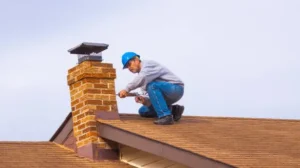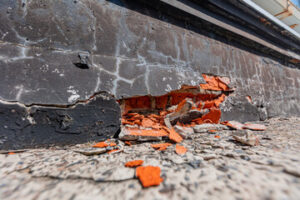Home » Articles posted by Dylan Campbell
Author Archives: Dylan Campbell
The Importance of Concrete Repair
Charleston Chimney Repair involve a condition evaluation to determine the current state of the structure and its causes of deterioration or distress. Suitable repair methods and materials are then selected to achieve the desired results.
Surface prep, mixing the correct material, and curing conditions all impact the durability of repaired concrete. Contractors should follow manufacturers’ advice and connect with experts to ensure a successful repair.

Concrete is a strong and durable material, but it can still crack. When this happens, it is important to repair it immediately. This will help to prevent water and other contaminants from entering the structure and causing damage or posing a health risk. Several methods can be used to repair concrete cracks. One of the most common is routing and sealing. This involves using a router to cut a V-shaped groove along the length of the crack and then filling it with an appropriate sealant. This quick and cost-effective method can fix a wide range of cracks.
Other crack repair methods include drilling and plugging. This consists of drilling holes along the length of the crack and then filling them with grout or epoxy. This will create a “key” that locks the crack and reduces the movement of surrounding concrete sections. This relatively quick and cost-effective method can repair cracks in old and new concrete structures.
In some cases, injecting concrete into a crack may be necessary. This is often used in structural repairs but also for aesthetic purposes. When injecting concrete into a crack, it is important to ensure that the correct ratio of water and concrete is used. Too much water can lead to a loss of strength, while too little water will result in a shrinkage crack. In addition, it is essential to use a high-quality injection material.
Some cracks can be injected with polyurethane or epoxy materials. This type of injection can be very effective in repairing cracks in concrete, but it is important to consult a professional before doing so. These professionals can advise on the best materials to use and provide guidance on the proper injection technique.
If a concrete slab has a wide crack that runs across the entire surface, it may be necessary to repair it. This will prevent the crack from reoccurring and can help improve the structure’s appearance. Sometimes, this can even be done without removing the existing concrete.
Concrete is intended to last a long time; however, if left untreated, the surface can degrade, and damage may occur. This can lead to holes or cracks in the concrete, which can be dangerous for pedestrians and vehicles. By repairing concrete surfaces early on, you can prolong their lifespan and prevent future damage, saving money in the long run.
Concrete repair can also have environmental benefits as it helps to avoid the need for expensive replacements. Removing old concrete is costly and laborious; however, fixing minor damage like holes and cracks can reduce the need for removal, which helps keep costs down. Concrete repair also helps to reduce waste as it eliminates the need for demolition and disposal, which can be detrimental to the environment.
When repairing small holes in concrete, the best option is to use a patching compound available in many different forms. It is important to clean the hole of any loose debris and ensure it is flat and level before applying the patching compound. Once you have brushed on a bonding agent (which can be purchased in a kit), you can use the patching material to fill the hole.
For larger holes in concrete, it is a good idea to use a slab jacking technique, which involves drilling several tiny holes into the damaged slab. Then, a foam is pumped into the holes, which lifts the slab back to its original position. This is much quicker, more affordable, and less invasive than removing the slab and pouring a new one.
Hiring a professional concrete repair contractor for required repairs is always a good idea. Not only will they have the necessary expertise and experience to complete the repair correctly, but they will also be able to advise you on preventative maintenance, which can help to keep your concrete in good condition for as long as possible. They will also have the proper equipment and high-quality materials to ensure your repairs are done properly.
A concrete slab is a rebar-enforced structural component built onsite using a form-work boxing mold. Concrete slabs are often used for floors and ceilings between support beams, girders, or columns. They are also used for outdoor paving. Regardless of what type of use they are put to, slabs are vulnerable to damage from earthquakes and soil movement. As such, they need to be checked regularly for cracks and damage. The earlier they are repaired, the less likely they will need replacement.
Concrete slab cracking or sinking is often a normal part of aging. However, it is important to err on the side of caution and consult an expert before dismissing any issue as normal. The good news is that many of these issues can be corrected with simple, permanent repair methods.
Slab cracks often occur when water erodes the materials under a slab, causing it to sink. This can be caused by flooding; water flows through pipes or burrowing animals. Regardless of the cause, most slab cracks do not present significant structural problems and can be fixed superficially by patching when minor or epoxy injection when over 18″ wide or structural.
Even though the load-bearing capacity of a concrete slab is high, the heaviness of cars and trucks on a driveway or garage floor will eventually wear down the concrete until it cracks. This is especially true for unevenly distributed vehicle weight, as some parts of the slab are subjected to more pressure than others.
Unlike other concrete repair methods that involve demolition and pouring a new slab, airlift’s polyurethane foam lifting method (known as “polyjacking” or “concrete leveling”) allows us to raise sunken concrete without the cost and hassle of tearing down a structure. We use a polyurethane foam that expands underneath the slab, filling any voids that may have formed, raising the slab, and sealing the underside of the slab to prevent it from sinking again. This is a much quicker and more economical alternative to traditional concrete slab repair methods such as mudjacking or slab jacking.
Although many DIY enthusiasts enjoy taking on home improvement projects, certain repairs are best left to professional foundation repair contractors. These contractors will have a variety of methods at their disposal to fix a range of problems that can affect the strength and stability of a foundation. Depending on the issue, specific techniques can be used to ensure the solution will be long-lasting.
One common method is helical piling. This involves a series of concrete cylinders driven below a foundation until they reach soil with the necessary load-bearing capability. A contractor will drill these cylindrical holes and pour liquid concrete into them to lift and stabilize the foundation. This will also help to correct any sinking that may be occurring.
Another popular technique is epoxy injection. This is usually carried out after event damage and can effectively repair cracks. This is a great option for fixing a wide range of issues and will ensure that the cracks in a concrete foundation are fixed permanently.
Aside from being an excellent method of repairing structural damage to a foundation, this is a quick and affordable approach to concrete repair. This is because it doesn’t require removing and installing new concrete.
In addition to these techniques, professionals can use several other solutions to fix various problems. These solutions can combine several approaches or be used for more complex issues.
Most importantly, the correct foundation repair method is chosen for each unique situation. Using the wrong method can lead to further damage and even more costly repairs.
If a crack in your foundation is 1/8 to 1/4 inch, it’s not a serious problem and doesn’t pose any structural risks. However, it’s a good idea to seal these cracks to keep out moisture, soil smells, and radon gas. If the cracks in your foundation are wider than this, you’ll need to hire a professional for concrete repair.
